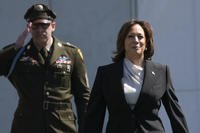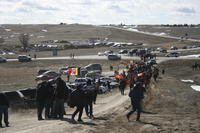The Air Force will allow recruits to have a greater percentage of body fat in an effort to reach more Americans as the service expects to fall short of its recruiting goals this year.
Male recruits are now allowed to have up to 26% body fat, and women are allowed 36%, Air Force Recruiting Service spokesperson Leslie Brown confirmed to Military.com on Tuesday. That's up from the previous requirement of 20% for men and 28% for women.
The change comes at a time when an increasing number of Americans are overweight, with that weight serving to bar many from service. The obesity epidemic, along with criminal histories for young Americans often tied to drug usage, means that only about 30% of young people are eligible to serve, according to the Centers for Disease Control and Prevention.
Read Next: Space Force Done Testing the Fit on its Uniforms, Ending the Loose Pants Saga
While recruits will be allowed to join with greater body fat percentages, they will still be expected to meet the same fitness standards as everyone else to stay in the service, Brown stressed. That means meeting the waist-to-height ratio requirement the Air Force announced in January and implemented this month.
"I can't stress enough: We are not lowering our standards, but rather we are aligning our standards with the overall DoD policy," Brown added in an email, citing a Defense Department instruction on fitness and body composition programs released last year.
The change in body fat standards for recruits is the latest effort to open up avenues to serve or to provide more incentives to attract recruits as all branches of the military struggle to meet their recruitment goals.
While the Air Force last year met its active-duty recruiting goal, it had to dip into its pool of delayed-entry applicants and so started this year at a deficit. This year, the service expects to miss its active-duty recruiting goal by 10%, Air Force Secretary Frank Kendall said last month.
The Army last year started approaching the obesity problem facing recruiting by offering pre-boot camp physical fitness classes to potential recruits who do not meet weight standards, a program officials have touted as a success. The Navy recently followed suit by offering its own physical fitness prep course to potential recruits who don't meet weight standards.
The Air Force expects its new increased body fat limits to allow 50 to 100 more recruits to join the service per month, though Brown added that estimate is based partially on anecdotal evidence.
For recruits who come in on the high end of the body fat standard, the Air Force's "medical community will ensure education and resources are in place to help these airmen reach a lower [body fat percentage] and meet the [body composition program] standard," Brown said.
The change in body fat standards for recruits stems from a team the Air Force announced last month that is looking into how the service can update recruitment policies. The team is led by Air Force Vice Chief of Staff Gen. David Allvin.
The Air Force has already made several changes to widen the pool of recruits, including allowing hand and neck tattoos and launching a pilot program for recruits who test positive for THC to retest.
The service is also trying to entice more people into joining by offering new incentives such as up to $65,000 in student loan debt repayment.
-- Rebecca Kheel can be reached at rebecca.kheel@military.com. Follow her on Twitter @reporterkheel.













